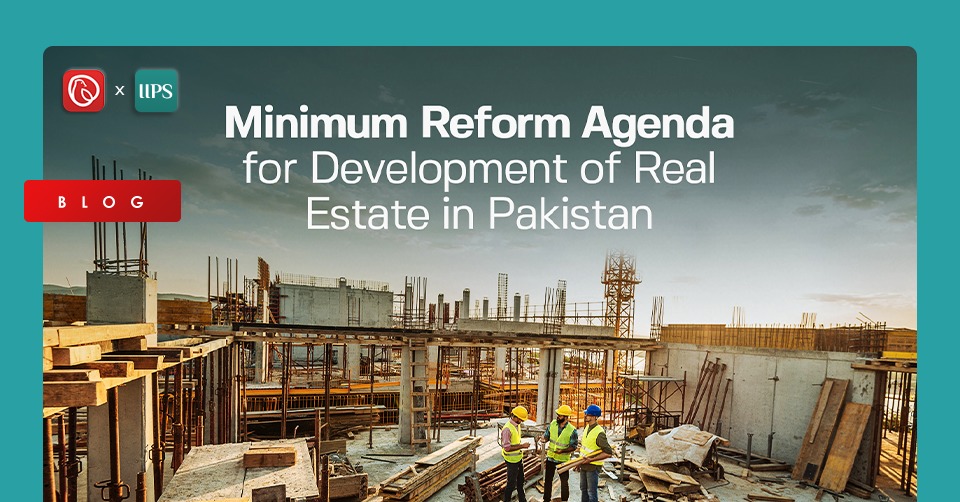Introduction
Real Estate is the largest segment of Pakistan’s economy. The sector is connected with the growth of 40 allied industries and 200 sub-industries including construction, cement, glass, and electronics. Despite its importance in economic growth, the sector lacks an institutional approach towards its development and regulation. The Iqbal Institute of Policy Studies (IIPS) organised a webinar titled “ The Role of Real Estate in Pakistan’s Economic Development” to highlight the significance of real estate in Pakistan’s economic development and discuss the challenges hindering the growth of the sector along with its remedial measures.
Research Questions
What are the challenges of urban planning in Pakistan?
What is the socioeconomic impact of comprehensive town planning?
What can be the minimum reform agenda for real estate development in Pakistan?
Challenges of Urban Development in Pakistan
Pakistan is the 5th most populous country globally, with 38 percent of its population living in urban areas. Cities are known as engines of growth; however, they can become a massive challenge for the economy and the environment without proper urban planning. Urban developers in Pakistan live below the poverty line as they are not considered an important part of the planning process. The biggest challenge of urbanisation is affordable housing. The issue takes precedence as the demand for housing is growing day by day. Horizontal expansion of cities is not only damaging the agricultural lands and the environment, but it also presents a significant challenge for the future sustainability of cities and their surrounding areas. Cities like Lahore and Karachi are increasing by 4.5 million residents every year. Whereas the city is growing at the lowest rate in South Asia, with livability also becoming worse. Water sanitation and management is also a significant threat to the sustainability of cities. Current water management services in Pakistani cities can only cater to 50 percent of the residents, with the prime source of water being groundwater extraction. This has depleted water reserves at an incredible speed, and by 2050, Pakistan is expected to face an acute water shortage. The sewerage mechanism is also a significant concern as waste from industrial zones also pollutes canals and rivers in Pakistan. In recent years, the excessive dumping of waste materials has led to contamination of groundwater reserves too. There is an urgent need to ban the extraction of groundwater and preserve the remaining groundwater. Recycling of water should also be introduced.
In terms of mobility and livability, an excessive level of encroachment can be seen in public spaces, which have left the public without basic amenities such as footpaths and bicycle lanes. There is also a massive focus on developing infrastructure for cars without keeping in mind the sustainability principles. An excellent way to tackle these challenges would be to increase the interconnectivity in cities so that people travel on foot, minimising the use of cars. Lastly, health and education services are also suffering in Pakistan’s urban centres. The two sectors remain primarily ignored by the government and have a shortage of resources required to run the current system. All in all, the speed at which the population is increasing in urban centres, it is feared that health and education services will deteriorate further if proper attention is not given to their development and maintenance. Therefore, keeping in mind these challenges, a separate ministry for urban planning must be constituted. This ministry should be responsible for making master plans of all major cities of Pakistan while also provisioning guidelines and regulations for their sustainable development.
Minimum Reform Agenda for Support and Betterment of Real Estate in Pakistan in Light of Actions Taken by LDA
There is a need to understand the nature of institutional reforms in Pakistan. Being an autonomous government body, the Lahore Development Authority (LDA) is responsible for the regional planning, building regulation, land-use, and private housing scheme approval of the areas under its control. The reform process started with the creation of a new master plan, setting new land-use rules, and defining building regulations. The incumbent government realised the importance of going vertical in cities as horizontal growth into agricultural lands is not sustainable. To address the challenge, LDA called upon architects, urban planners, environmentalists, and members of the Association of Buildings and Developers (ABAD) to present their recommendations. The effort remained focused on giving support to high-rise buildings in Lahore. Previously, anyone could construct a high-rise building in a residential area as long as the plot size was at least 4 kanal with a maximum building height of 80ft. This posed a challenge for small developers as plots above 4 kanal are not easily available and are highly costly. As the height was also limited to 80ft, the price of a single unit also remained extremely high. New regulations introduced by the LDA now allow for the construction of high-rise buildings on 10 marla plots in Islamabad with a maximum height of 40 metres, 1 kanal plots with 90 metres, and 2 kanal plots with 160 metres. The new regulations have resulted in the consecutive construction of 150 new buildings in Lahore. Added benefits are also given in terms of commercial areas where a building can allow two shops on the ground floor, not exceeding in size of more than 2 marlas, for convenience stores and general amenities. This can be done without paying the fee for commercialisation.
The Lahore Development Authority (LDA) has also revised rules for private housing schemes. Boosting the development of housing requires easily adoptable rules and regulations. The standard time for approval of a housing scheme in Lahore stood at around 3 to 5 years, causing the equity of the landowner to remain stuck for a long time. The practice resulted in the formation of many illegal housing societies. The targets set under the new regulations allow for a 60-day approval period and eliminates useless processes such as obtaining a preliminary planning permission (PPP) certificate. The certificate indicated that a developer now has the authority to carry out planning in LDA administered areas. It also took anywhere from 2 to 3 years to get the certificate, and the common man could be easily defrauded as a PPP could be obtained without actually buying the land. Illegal developers sold housing units based on this approval as most people do not understand the legal requirements of developing a housing society. Now, one approval is required which can only be obtained by the landowner after verifying his ownership. Under this scheme, housing societies are being approved within 120 days and no illegal societies are emerging in Lahore.
LDA has also set out a new land-use commercialisation policy under which a grievance redressal committee has been formed for the speedy resolution of business community problems. Previously, the community had to reach out to separate ministries for mundane tasks which could easily be carried out by LDA. The new committee will allow for greater interaction with the business community along with increased private sector involvement in the policymaking process. More than 8500 residential maps, 450 high-rise buildings, and 30,600 Kanals of residential private buildings have been approved since the step was taken. It has resulted in Lahore becoming the top city for construction in Pakistan. Therefore, as long as the policy is set out for the people, economic growth and employment can be boosted. The job of the government is to facilitate regulation, support economic growth, and create more transparency.
If you are searching for the best investment opportunities, visit: Luxury Apartments in Islamabad.
Conclusion
The perception that real estate is related to just buying and selling of land is an outdated understanding. Real estate not only includes the urban and agricultural land, but it is also a major part of the services and industry sector of the economy. There is a serious lack of information regarding the sector’s growth and performance.. A high per capita demand for housing coupled with investments flowing into the country in the form of remittances means that the real estate sector has the potential to revitalise and uplift the economic development of Pakistan.
Key Takeaways
- Pakistan is the 5th most populous country globally, with 38 percent of its population living in urban areas.
- Cities are known as engines of growth; however, they can become a massive challenge for the economy and the environment without proper urban planning.
- Horizontal expansion of cities is not only damaging the agricultural lands and the environment, but it also presents a significant challenge for the future sustainability of cities and their surrounding areas.
- Water sanitation and management is also a significant threat to the sustainability of cities. Current water management services in Pakistani cities can only cater to 50 percent of the residents, with the prime source of water being groundwater extraction.
- This has depleted water reserves at an incredible speed, and by 2050, Pakistan is expected to face an acute water shortage.
- Being an autonomous government body, the Lahore Development Authority (LDA) is responsible for the regional planning, building regulation, land-use, and private housing scheme approval of the areas under its control.
Bibliography
Iqbal Institute of Policy Studies. (2021). The Role of Real Estate in Pakistan’s Economic Development. Islamabad: IIPS. Available at https://www.facebook.com/iipstudies/videos/343918290667468




